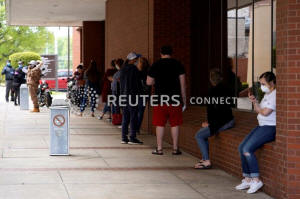U.S. weekly jobless claims seen underscoring deepening
economic slump
 Send a link to a friend
Send a link to a friend
 [April 16, 2020] By
Lucia Mutikani [April 16, 2020] By
Lucia Mutikani
WASHINGTON (Reuters) - Millions more
Americans likely sought unemployment benefits last week, lifting total
filings for claims over the past month above an astounding 20 million,
which would underscore the deepening economic slump caused by the novel
coronavirus outbreak.
Thursday's weekly jobless claims report from the Labor Department will
follow dismal data on Wednesday showing a record drop in retail sales in
March and the biggest decline in factory output since 1946.
Economists are predicting the economy, which they believe is already in
recession, contracted in the first quarter at its sharpest pace since
World War II.
Weekly jobless claims, the most timely data on the economy's health, are
being closely watched for clues on the depth of the downturn, when the
waves of layoffs may let up and when a recovery might start.

"The decline in economic activity is breathtaking," said Joel Naroff,
chief economist at Naroff Economics in Holland, Pennsylvania. "While we
will see an initial upturn once the economy reopens, the strength and
length of that recovery is not clear at all."
Initial claims for state unemployment benefits probably totaled 5.105
million in the week ended April 11, according to a Reuters survey of
economists -- a staggering number even though lower than the previous
week's 6.606 million. Estimates in the survey were as high as 8 million.
Going by the average forecast, last week's claims data would bring the
cumulative unemployment benefits claims to more than 20 million since
the week ending March 21.
Economists are divided on whether the anticipated second straight weekly
decline in claims suggests that filings peaked at a record 6.867 million
in the week ended March 28, or that overwhelmed state employment offices
were unable to process the flood of applications.
"We expect that claims will remain very elevated in coming weeks as
states struggle to clear backlogs and more companies lay off workers in
response to the shutdown," said Joseph Briggs, an economist at Goldman
Sachs in New York.

"Including this week, we currently project an additional 20 million in
initial jobless claims through the end of May, after which we expect new
claims to fall to levels consistent with prior recessions."
[to top of second column] |

People who lost their jobs wait in line to file for unemployment
following an outbreak of the coronavirus disease (COVID-19), at an
Arkansas Workforce Center in Fort Smith, Arkansas, U.S. April 6,
2020. REUTERS/Nick Oxford/File Photo

ECONOMIC CARNAGE
States and local governments have issued "stay-at-home" or "shelter-in-place"
orders affecting more than 90% of Americans to control the spread of COVID-19,
the respiratory illness caused by the virus, and abruptly halting economic
activity. Retail sales and production at factories tanked in March.
Economists are estimating the economy contracted as much as 10.8% in the first
quarter, which would be the steepest drop in gross domestic product since 1947.
They say a historic $2.3 trillion fiscal package, which made provisions for cash
payments to some families and boosted unemployment benefit checks, will likely
provide little cushion to the economy.
Economists say the economy entered recession in March.
The National Bureau of Economic Research, the private research institute
regarded as the arbiter of U.S. recessions, does not define a recession as two
consecutive quarters of decline in real GDP, as is the rule of thumb in many
countries. Instead, it looks for a drop in activity, spread across the economy
and lasting more than a few months.
Jobless claims filed this week, data for which will be published next Thursday,
will have additional significance as they will cover the period during which the
government surveyed business establishments for its April employment report.
Economists expect millions of job losses this month after the economy purged
701,000 jobs in March, the biggest loss of jobs since the 2007-2009 Great
Recession. Last month's job losses also ended an employment boom that started in
late 2010, which was the longest in U.S. history.

"The speed and scale of job losses will be more similar to a natural disaster
than a typical recession," said Dante DeAntonio, an economist at Moody's
Analytics in West Chester, Pennsylvania. "Overall job losses in April could be
10 to 20 times larger than those in March."
Thursday's claims report is also expected to show the number of people
continuing to receive benefits after an initial week of aid raced to a fresh
record of 13.5 million from 7.455 million in the prior week, according to the
Reuters survey.
The so-called continuing claims data is reported with a one-week lag and is
viewed as a better gauge of unemployment. Economists expect the unemployment
rate will in April blow past the Great Recession's peak of 10.0% and the
post-World War II high of 10.8% touched in December 1982.
(Reporting by Lucia Mutikani; Editing by Chizu Nomiyama)
[© 2020 Thomson Reuters. All rights
reserved.] Copyright 2020 Reuters. All rights reserved. This material may not be published,
broadcast, rewritten or redistributed.
Thompson Reuters is solely responsible for this content. |